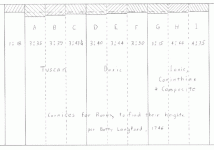Guys, George, Adam et al,
I have been reading and studying Mack Headley's Tea Table article in FWW. I have broken down the Ionic Order he uses to numbers and wanted to post them here to get input. I don't think the width of the leg is correct and would like anyone opinion on this. I would prefer to have posted a drawing but don't know how to do that on this site. Opinions on what to use Sketch up etc and how to post would be great also.
Ok, here is what I calculated following the article which uses Ionic Column.
1. Total height that I picked for my table is 30 inches.
2. The Pedestal is 1/5 of the total height. So 30 divided by 5 equals 6 inches.
Pedesal = 6 inches.
3. The Entablature is 1/6 of the height less Pedestal. So 30 minus 6 = 24
24 divided by 6 = 4 Entablature = 4 inches.
4. The shaft would be the height less the Pedestal and Entablature.
Shaft = 24inches (30 minus 6 minus 4)
5. The module is 1/9 of the height of the shaft. So 24 divided by 9 = 2.222
So, wouldn't that mean that the width of a 30 inch leg would be 2.22 inches? Also, I noticed that Headley did another calculation that included the Entablature and the shaft to determine the inner and outer limits of the leg. I am not sure what is going on here and how to understand this calculation. I took a ruler and measured the drawing in the article and then measured where he labled "module" and tried to determine if the module was 1/9 of the height with the Entablature or what but was not able to determine this.
It seems that a 2.22 inch leg would be too thin to allow a cabriole curve, but I don't have experience with this. Thoughts anyone?
I have been reading and studying Mack Headley's Tea Table article in FWW. I have broken down the Ionic Order he uses to numbers and wanted to post them here to get input. I don't think the width of the leg is correct and would like anyone opinion on this. I would prefer to have posted a drawing but don't know how to do that on this site. Opinions on what to use Sketch up etc and how to post would be great also.
Ok, here is what I calculated following the article which uses Ionic Column.
1. Total height that I picked for my table is 30 inches.
2. The Pedestal is 1/5 of the total height. So 30 divided by 5 equals 6 inches.
Pedesal = 6 inches.
3. The Entablature is 1/6 of the height less Pedestal. So 30 minus 6 = 24
24 divided by 6 = 4 Entablature = 4 inches.
4. The shaft would be the height less the Pedestal and Entablature.
Shaft = 24inches (30 minus 6 minus 4)
5. The module is 1/9 of the height of the shaft. So 24 divided by 9 = 2.222
So, wouldn't that mean that the width of a 30 inch leg would be 2.22 inches? Also, I noticed that Headley did another calculation that included the Entablature and the shaft to determine the inner and outer limits of the leg. I am not sure what is going on here and how to understand this calculation. I took a ruler and measured the drawing in the article and then measured where he labled "module" and tried to determine if the module was 1/9 of the height with the Entablature or what but was not able to determine this.
It seems that a 2.22 inch leg would be too thin to allow a cabriole curve, but I don't have experience with this. Thoughts anyone?

